Classroom Observations: The Power of Reflection
Teaching is an art, learning is science. Both must blend in order to optimize the learning experience. The ability to reflect is a desired skill in every profession. Reflective practice is required because teachers of the future should be thoughtful decision-makers and intrinsically motivated to analyze a situation.
Teachers must set goals, monitor learning, assess and reflect on their professional practice. Keeping the larger goal in mind, our schools need reflective teachers who can fine-tune their methods to find better ways of teaching while maintaining their purpose and direction.
Several aspects of teacher development have been overlooked in the preparation and promotion of effective teachers. The emphasis has been more on the development and demonstration of teacher’s understanding of content, its delivery and in their capacities to improve results.
The journey of a teacher begins by understanding the various processes, planning for hours before each class and working out multiple strategies to manage the class. Over the period of time, planning, teaching, and assessing become effortless activities. On the downside, there have always been a few children who do not understand what is taught, do not do well in tests and are passive participants in the classroom. If we believe that all students can learn optimally and that our performance as a teacher has a direct impact on our student’s learning, then what should our homework be?
Given all the dilemmas that characterize today’s classrooms, our homework should be to REFLECT — reflecting on What we do in the classroom? How do we teach? Why we teach the way we do? How could we do things differently and create change? How we engage the students? How we build curiosity? Our thoughts about children and their attitudes are central to our reflection. It is, therefore, imperative for educators to recognize the multi-layered world of education, which has roots far deeper than we can think of.
We must understand our role as mentors in terms of enhancing skills and emphasizing the responsibilities of an enlightened citizen by instilling discernment and self-awareness amongst our students.
Classroom observation in this regard is a powerful tool to enable students and teachers to develop an analysis of feelings, evaluation of experiences and designing an action plan.
For teachers to be effective, they need to recognize more than just their students’ background and learning preferences. It is, therefore, not only desirable but almost essential to create teachers who can understand the relevance of reflection, particularly about teacher education. For making reflective teaching visible, classroom observations play a central role. It offers teachers an opportunity to think about what works in the classroom and what does not.
Classroom observations provide teachers with constructive critical feedback to reflect upon their classroom management and instructional techniques .
Classroom observations advocate that no matter how thorough the preparation of a lesson is, the teaching strategies must be manoeuvred as per the needs and pace of learners. This practice of classroom observation ensures teachers gain a better understanding of their teaching methodologies through individual reflections, reflection with partners, reflection in small groups and school-wide reflection.
This article deliberates upon the affirmative actions of classroom observation practices that we deploy in our school DLF World School, Greater Noida, to improve the educational outcomes of students. I hope it will help other teachers in this community too.

Incorporating observation tools and collaborative reflections
WHAT IS CLASS OBSERVATION?
Educators observe each other’s practice, providing feedback and learning from each other:
- to improve their impact on students’ learning, focused on improving teacher practice in alignment with learner needs and school priorities
- to address the stated goal of providing the teacher with relevant feedback based on their interactions with students and making improvements in their classroom management and instructional techniques
WHY DO TEACHERS NEED CLASS OBSERVATIONS?
It provides effective professional learning that emphasizes reflection and feedback on practice to improve learning
- develops teachers’ awareness about their own teaching practice and its impact.
- can help determine professional learning needs at the individual and school level.
- supports the development of a common understanding of effective teaching practices that have an impact.
- supports sharing of ideas and expertise among teachers including modelling of good practices.
- provides opportunities to discuss challenges and concerns with colleagues.
PURPOSE OF CLASS OBSERVATION
The fundamental purpose of classroom observation is to improve student outcome by improving the instructional prowess of the teacher.
A secondary purpose of observation is to perform an investigation into possible inequities in instruction among different groups of students. This allows teachers to identify biases in how different groups of students are treated based on their gender, socio-economic standing, or other differentiating factors to help eliminate them. A final purpose is to provide school administrators with information on current educational practices and to identify instructional problems.
WHAT ARE THE KEY ELEMENTS?
There are some key skills and things that are at the core of classroom observations –
- Class observations are drawn on skills used
- in everyday teaching
- in understanding the content
- in providing discipline
- in non-judgemental observation in a non-threatening environment
- in maintaining objectivity
- and in reducing bias
2. Agree on focus for classroom observations and shared protocols
3. Develop trust between teachers observing and being observed
4. Collegial commitment to the ongoing development of practice
ACTIONS INVOLVED?
- Plan : Invite staff to participate in establishing the conditions or ground rules for initiating observation practices e.g., what strategy will be used, how will people nominate to observe/be observed?
- Gradual steps: Begin with small changes. e.g., encourage staff to visit each other’s classrooms for 5 -10 min and think about observed best practices and how they could incorporate and adapt them in their own class.
- Establish supportive structures: provide time for observation. Encourage staff to begin working with others they feel comfortable with and establish collaborative groups to initiate conversations about learning across the school.
- Offer choice: It allows staff some control over who observes and the timings of observation.
- Collaborate: Build opportunities into schedules for teachers to work together on common goals, provide support and structures to ensure the staff are jointly planning and problem-solving.
- Teacher Appraisals: Incorporate classroom observations into the school’s performance and development cycle.
- Reflection and goal setting: Data from classroom observations help set goals effectively and realistically as it provides evidence of the impact of teachers practice and therefore, the strengths and areas for development.
- Ongoing feedback, reflection and review: Data from observations help to evidence the performance and development in review discussions and ascertain goal achievement.
METHODOLOGY
The process of observation and evaluation requires a very high degree of professional ethics and objectivity and training in observational and analytical skills.
Checklists, charts, rating scales, and narrative descriptions are examples of observational techniques that have proven to be effective ways of examining a teacher in action.
One of the main challenges for observation is to decide upon the rubric tool which can vary from school to school.
Things to keep in mind while designing the class observation techniques
Lesson structure.
- The way the lesson opens develops and closes.
- The number of activities that constitute the lesson.
- The links and transition between activities.
Classroom Management Strategies
- Setting up groups
- Maintaining discipline
- Time management
- Seating arrangements
Teaching and activities
- Class activities
- Pair and group work activities
- Individual activities
- Use of textbooks
- Use of other resources/teaching aids/online educational tools
Use of language – Teachers
- Use of instructional language
- Questioning technique
- Explanation of vocabulary and new keywords
Use of language – Students
- Use of language in group work
- Use of mother tongue in class
- Problems with grammar/pronunciation
Feedback and recapitulation
- Time on task
- Alternate assessment tools
- Student response mechanism
Conclusion
Classroom observation offers teachers collaborative reflection opportunities for continuous improvement. Observation tools and collaborative reflection can be leveraged to achieve learning goals, clarify expectations, provide targeted feedback, and gather information to enhance the academic experience for both teachers and students.
By incorporating observation tools and collaborative reflection into the continuous improvement process, promote a sense of shared responsibility, trust, and collegiality. Through this process, teachers emerge as evidenced-based practitioners better prepared to implement and share best practices to positively impact student outcomes.
Share this:
classroom observations Classroom techniques
Written by Dimple Puri
Ms. Dimple Puri is the Head of School at Darbari Lal Foundation World School. A progressive leader, she has had varied experience of over 20 years in the field of education. She is a post graduate in Botany and B.Ed from Guru Nanak Dev University, Amritsar (Punjab). She started her career as a Science teacher and has taught Biology to the senior classes. She had an opportunity to serve as a Headmistress at Ahlcon International School before joining DLF World School and has led a team with an expertise in varied fields of curriculum planning, inclusivity, pedagogy and innovation, value based education, resource management, capacity building of teachers, research based classroom practices, engaging classroom program, SDG based activities and creating flexible learning spaces in the classroom context. She is a British Council School Ambassador and is actively involved with the assignments like assessment and briefings sessions. She has authored several educational articles in prestigious journals. She has also been conferred twice with Life Empowerment Award in the category of Teacher Leader ship in Life skills and Value Education and Inclusive Education for children with special needs by Expressions India in collaboration with CBSE. She has also received the Rex Karamveer award for contribution in the field of social inclusion.. She has also represented on various International and National platforms like PASCH Principals Meet 2017 held in Bangkok. She envisions to create Darbari Lal Foundation World School as a thinking school with a learning centered environment in which students and educators are actively involved as curators and co-constructors of knowledge.
One Comment
This is one of the crucial area . No bias should be there in the reports.
Leave a Reply Cancel reply
You must be logged in to post a comment.
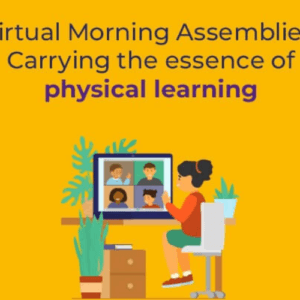
Morning Assemblies in the Virtual World
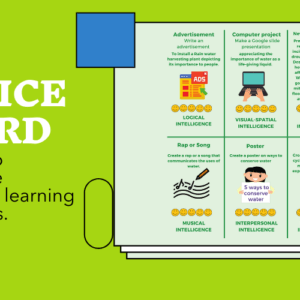
Use Choice Boards to increase Student Ownership
© Copyright 2024 Cambridge. All Rights Reserved.
Username or Email Address
Remember Me
Don't have an account? Register
Forgot password?
Enter your account data and we will send you a link to reset your password.
Your password reset link appears to be invalid or expired.
Privacy policy.
To use social login you have to agree with the storage and handling of your data by this website.
Add to Collection
Public collection title
Private collection title
No Collections
Here you'll find all collections you've created before.
Report Post
Please log in to report posts

Classroom Observation Report
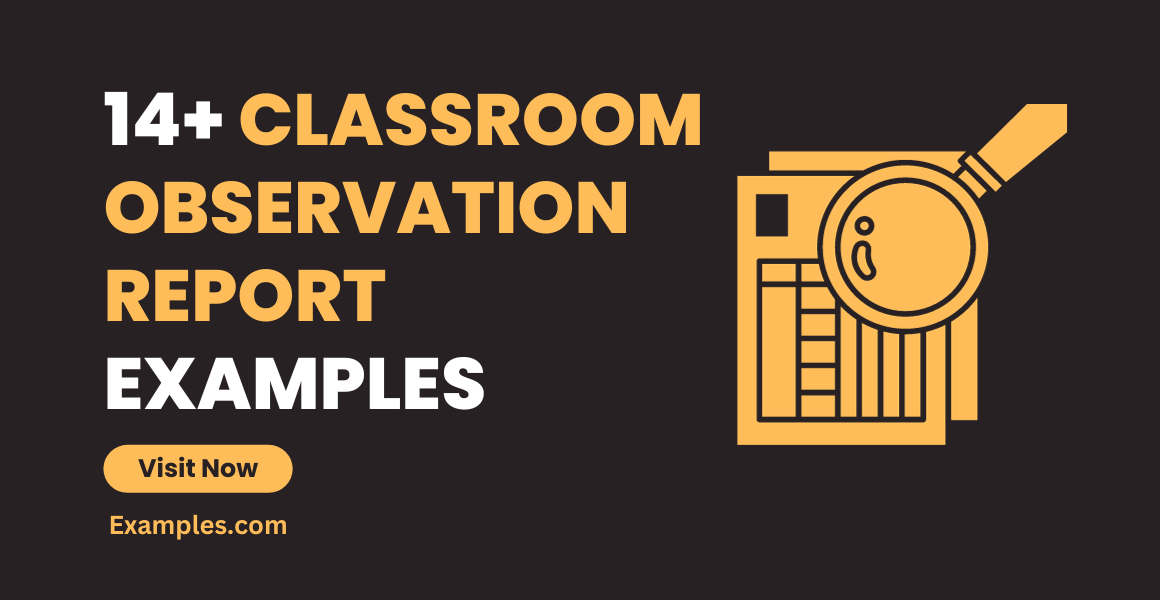
Teachers or substitute teachers would know that observing children and students in the classroom can be a difficult task. As each student has their own unique trait as well as their own attention capacity. For a teacher or a substitute teacher, they must find ways to encourage their students to interact, especially if they are handling children. An observation report is a good enough way to list all the details or the information they got from watching how their students interact in the classroom. To get an idea on what you can do with an observation report, check out the article below.
14+ Classroom Observation Report Examples
1. classroom observation report template.
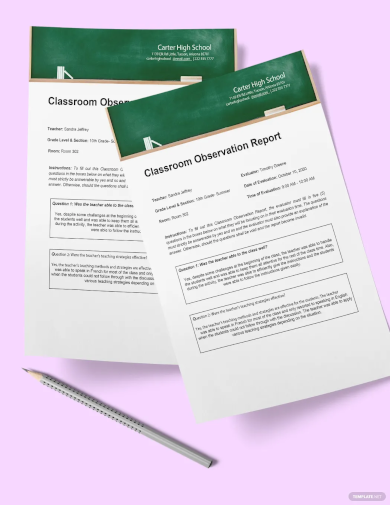
- Google Docs
Size: 135 KB
2. School Classroom Observation Report Template
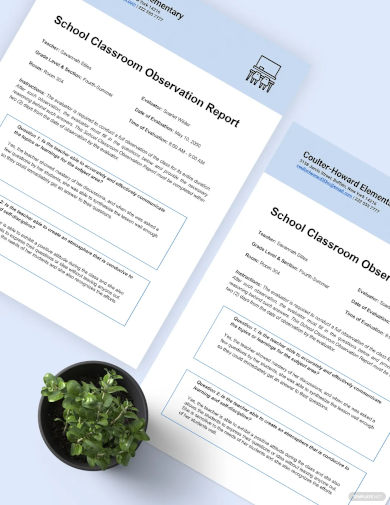
Size: 196 KB
3. Sample Classroom Observation Report Template

Size: 77 KB
4. Teacher Classroom Observation Report Template
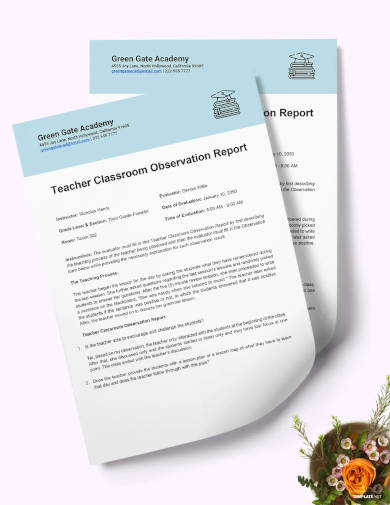
5. Kindergarten Classroom Observation Report Template
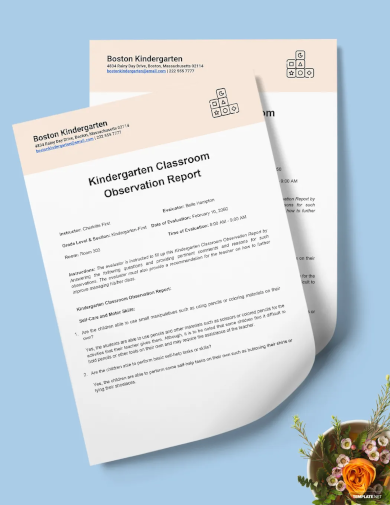
Size: 126 KB
6. Classroom Observation Report
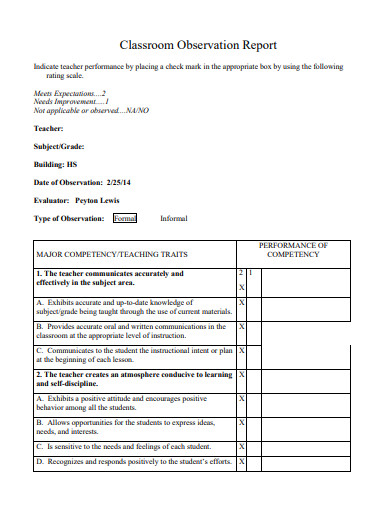
Size: 212 KB
7. Student Teaching Observation Report
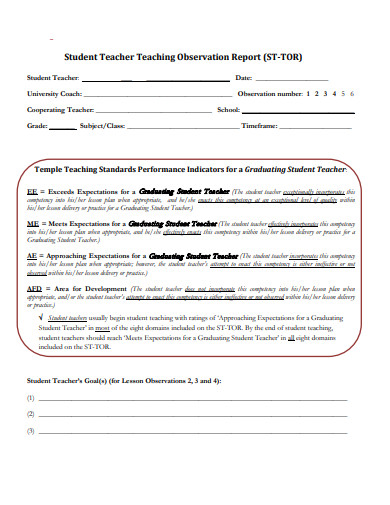
Size: 269 KB
8. Open-Ended Classroom Observation Report
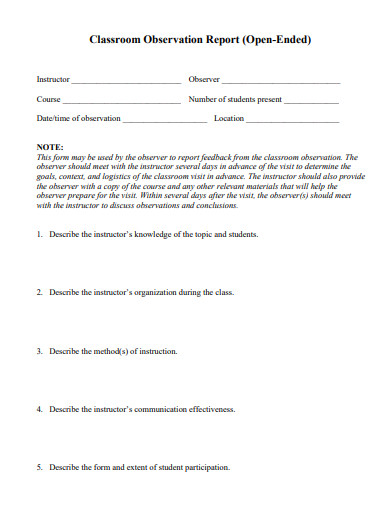
Size: 16 KB
9. Peer Classroom Observation Report
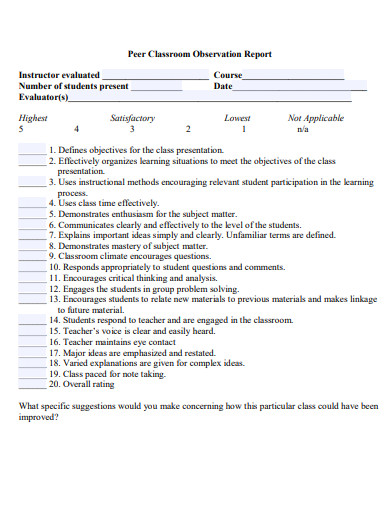
Size: 13 KB
10. Sample Classroom Observation Report
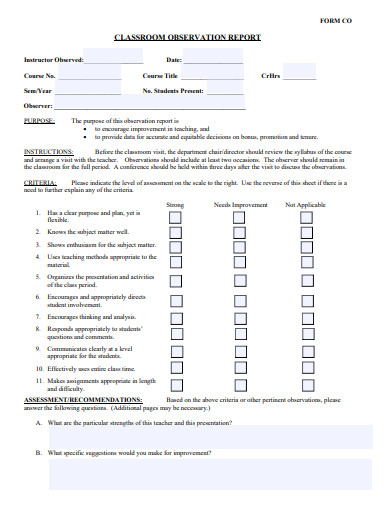
Size: 43 KB
11. Simple Classroom Observation Report

Size: 95 KB
12. Teacher Classroom Observation Report
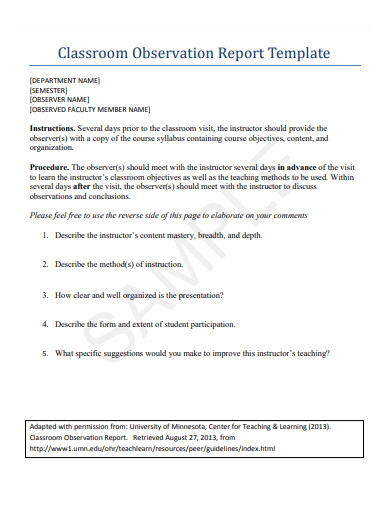
Size: 788 KB
13. Pre-Student Teaching Observation Report
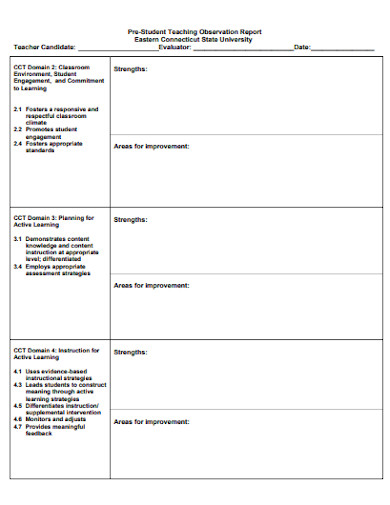
14. Classroom Observation Report Example
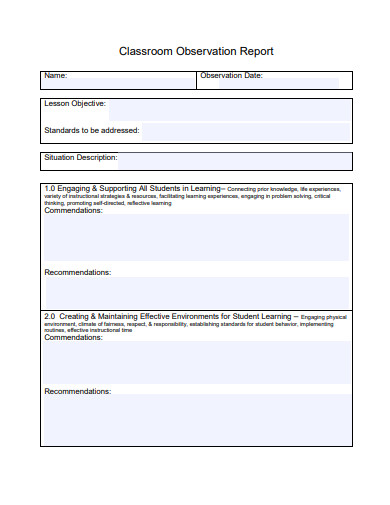
Size: 125 KB
15. Printable Classroom Observation Report
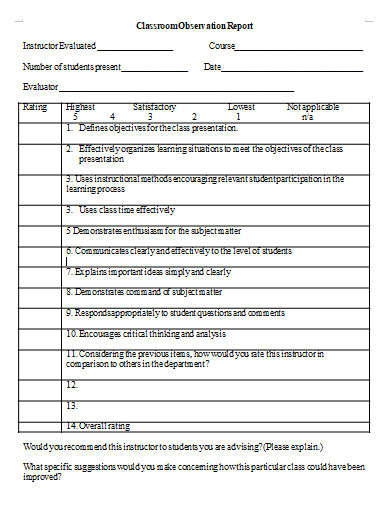
What Is an Observation?
An observation is the act of seeing something that you have not seen before. The process of observing and watching. In addition to that, an observation is the act of seeing someone or something to gain information about it. An observation is the act of looking at something or someone in a curious or genuine manner. To get to know a person or a thing by watching them without making much judgement. To get any understanding and information by observing something or someone.
What Is a Report?
A report is a document that is written by someone who has something to say. It can be in the form of a complaint, an observation, a topic to be discussed, or even to simply want to inform someone about something. Reports are also considered an official document that describes incidents that may have happened. In addition to that it means to give full detail about something or someone. The information that is found in the report can be used for future information that may be useful for whatever purpose it was given. Lastly, a report can also be either in written form or presented orally.
What Is an Observation Report?
An observation report is a document that stores information about a child or about children and the way they interact with their peers. Observation reports are mostly done by teachers or health care professionals. As this document is mostly used for understanding the well being of the child. This document contains the general and sometimes specific information about a child’s overall development. It is also the process besides observing the child, you are also observing how they act in their own environment and how they perceive things. You are also going to be writing them down as well as putting all the observations into one report.
How Important Is a Classroom Observation Report?
The importance of writing a classroom observation report is to know and understand where your students may be struggling at. The areas in which a student has the opportunity to know where they can improve. A classroom observation report can also show the strengths and weaknesses of the students. In addition to that, it also helps by performing an investigation report that may be needed to check on the progress of your students. As well as if any incidents may arise, a classroom observation report is the best tool to use for gathering data or information about your students.
What Are the Tools?
- Questionnaire
How to Write a Classroom Evaluation Report?
- Do a thorough observation of your students
- Write your observations down
- Start doing your assessment and evaluation
- List the evaluations and results
- Pile them up to make a general evaluation report
- Make a copy of your own and send it to your superiors
What is a classroom evaluation report?
A classroom evaluation report is a type of report that is documented to know and understand how a student reacts and interacts in their surroundings. It is used mostly by teachers as a way to see and to use as an intervention report. In case of any incidents or accidents that may fall on the classroom, they are able to record it and find a solution.
How can a classroom evaluation report be useful for a teacher?
Classroom evaluation reports are a bundle of information made through observing your students. Their personalities, how they interact, their strengths and weaknesses all written down for your convenience. The evaluation report is useful when you have assessed and evaluated the problem and are able to find a solution for it. Just like any type of report, an evaluation report requires data or information to be able to find a solution. This is one way of using your classroom evaluation report.
Is there a format for writing your evaluation report?
Not necessarily. You may choose how you want to write your evaluation report. As long as you remember to treat this report as a legal document. You should also avoid using jargon that may not be as familiar to others who may read your report.

Do I need to write down all the observations I had inside my classroom?
In a general way, you may want to write all the observations in a paper. But when you want to write your evaluation report, stick to the most important information.
Anyone who may have taught or is currently teaching students, especially children would know that anything can really happen inside the classroom. That students differ from others and there is no such thing as two students with the same attitude or personality. These observations can be quite helpful especially if you are trying to resolve an issue concerning your students. By using a classroom evaluation report, you are surely able to find a solution to the problems that your students may be facing. As well as a good way of implementing rules based on the observation report you made.
Report Generator
Text prompt
- Instructive
- Professional
Generate a report on the impact of technology in the classroom on student learning outcomes
Prepare a report analyzing the trends in student participation in sports and arts programs over the last five years at your school.
Home — Essay Samples — Education — Classroom — My Observation In The Classroom
My Observation in The Classroom
- Categories: Classroom
About this sample

Words: 742 |
Published: Mar 25, 2024
Words: 742 | Pages: 2 | 4 min read

Cite this Essay
Let us write you an essay from scratch
- 450+ experts on 30 subjects ready to help
- Custom essay delivered in as few as 3 hours
Get high-quality help

Dr. Karlyna PhD
Verified writer
- Expert in: Education

+ 120 experts online
By clicking “Check Writers’ Offers”, you agree to our terms of service and privacy policy . We’ll occasionally send you promo and account related email
No need to pay just yet!
Related Essays
2 pages / 982 words
3 pages / 1570 words
1 pages / 621 words
1 pages / 462 words
Remember! This is just a sample.
You can get your custom paper by one of our expert writers.
121 writers online
Still can’t find what you need?
Browse our vast selection of original essay samples, each expertly formatted and styled
Related Essays on Classroom
Learning is a crucial process for students as it acts as a changing factor in their lives. The process, therefore, requires ample time and proper concentration for the successful occurrence. Class size is a factor to be [...]
Classroom management is a critical component of a successful teaching experience. Without proper management techniques, teachers may struggle to maintain control over their classroom, resulting in disruptions, lack of student [...]
Special education classrooms are designed to meet the unique needs of students with disabilities. These classrooms often have a different structure and focus compared to general education classrooms. Observing a special [...]
Classroom management is a crucial aspect of teaching that directly impacts student learning and behavior. As a teacher with several years of experience, I have encountered various challenges and successes in managing my [...]
Do teachers change when they are evaluated? Do parents worry about their kids being in school? Have many students been accused of something they didn’t do? All of these problems can be eliminated with one little piece of [...]
Flipped classroom is an instructional strategy and a type of blended learning that reverses the traditional learning environment by delivering instructional content, often online, outside of the classroom. It moves activities, [...]
Related Topics
By clicking “Send”, you agree to our Terms of service and Privacy statement . We will occasionally send you account related emails.
Where do you want us to send this sample?
By clicking “Continue”, you agree to our terms of service and privacy policy.
Be careful. This essay is not unique
This essay was donated by a student and is likely to have been used and submitted before
Download this Sample
Free samples may contain mistakes and not unique parts
Sorry, we could not paraphrase this essay. Our professional writers can rewrite it and get you a unique paper.
Please check your inbox.
We can write you a custom essay that will follow your exact instructions and meet the deadlines. Let's fix your grades together!
Get Your Personalized Essay in 3 Hours or Less!
We use cookies to personalyze your web-site experience. By continuing we’ll assume you board with our cookie policy .
- Instructions Followed To The Letter
- Deadlines Met At Every Stage
- Unique And Plagiarism Free
- Undergraduate
- High School
- Architecture
- American History
- Asian History
- Antique Literature
- American Literature
- Asian Literature
- Classic English Literature
- World Literature
- Creative Writing
- Linguistics
- Criminal Justice
- Legal Issues
- Anthropology
- Archaeology
- Political Science
- World Affairs
- African-American Studies
- East European Studies
- Latin-American Studies
- Native-American Studies
- West European Studies
- Family and Consumer Science
- Social Issues
- Women and Gender Studies
- Social Work
- Natural Sciences
- Pharmacology
- Earth science
- Agriculture
- Agricultural Studies
- Computer Science
- IT Management
- Mathematics
- Investments
- Engineering and Technology
- Engineering
- Aeronautics
- Medicine and Health
- Alternative Medicine
- Communications and Media
- Advertising
- Communication Strategies
- Public Relations
- Educational Theories
- Teacher's Career
- Chicago/Turabian
- Company Analysis
- Education Theories
- Shakespeare
- Canadian Studies
- Food Safety
- Relation of Global Warming and Extreme Weather Condition
- Movie Review
- Admission Essay
- Annotated Bibliography
- Application Essay
- Article Critique
- Article Review
- Article Writing
- Book Review
- Business Plan
- Business Proposal
- Capstone Project
- Cover Letter
- Creative Essay
Dissertation
- Dissertation - Abstract
- Dissertation - Conclusion
- Dissertation - Discussion
- Dissertation - Hypothesis
- Dissertation - Introduction
- Dissertation - Literature
- Dissertation - Methodology
- Dissertation - Results
- GCSE Coursework
- Grant Proposal
- Marketing Plan
- Multiple Choice Quiz
- Personal Statement
- Power Point Presentation
- Power Point Presentation With Speaker Notes
- Questionnaire
- Reaction Paper
- Research Paper
- Research Proposal
- SWOT analysis
- Thesis Paper
- Online Quiz
- Literature Review
- Movie Analysis
- Statistics problem
- Math Problem
- All papers examples
- How It Works
- Money Back Policy
- Terms of Use
- Privacy Policy
- We Are Hiring
A Guide To Classroom Observation, Essay Example
Pages: 3
Words: 724
Hire a Writer for Custom Essay
Use 10% Off Discount: "custom10" in 1 Click 👇
You are free to use it as an inspiration or a source for your own work.
The paper discusses the concept and meaning of classroom observation of a professor lecturing. The meaning and benefits of classroom observation are discussed. The paper points out what one can learn from classroom observation. The methodological and pragmatic limitations of classroom observation are evaluated and discussed.
Classroom Observation
Classroom observation is a complex qualitative/ quantitative technique of measuring teacher and student behaviors in the classroom and the effects they produce on student learning outcomes. Classroom observations exemplify an essential component of teachers’ support. Classroom observation can provide teachers with a unique opportunity to monitor the quality of the learning process from multiple perspectives. That classroom observation can facilitate the development and implementation of numerous good practices is a well-known fact. However, student observers must be aware of the methodological and pragmatic difficulties of classroom observation and be prepared to overcome these barriers in their way to better quality of learning and knowledge delivery in the classroom.
Being a classroom observer is a transitional role; put simply, the process of observing professor lecturing will be different for different students (Adelman & Walker, 2004). Yet, being a classroom observer is hardly a temporary role, because students tend to internalize their observation skills, to use them later in their own teaching (Adelman & Walker, 2004). The best teachers and lecturers are those who can distance themselves from their classroom activities, see themselves in ways other students/ teachers see them, and adjust their learning activities accordingly (Adelman & Walker, 2004). Classroom observation is the source of primary knowledge about professor lecturing behaviors and their effects on the learning process in the classroom. Classroom observation is both the source and the instrument of significant contribution to the self-evaluation processes in classroom activities. It enables students and teachers to reinforce more effective learning strategies and contribute to the quality of student learning in the classroom.
Classroom observation is “the most direct method for the change facilitator to use in helping teachers to monitor and assess their own teaching practice” (Uys & Gwele, 2005, p.103). It allows monitoring teachers in action, to identify their strengths and weaknesses and develop and effective plan of action. Objectively, classroom observation should not be carried out by school supervisors; teachers should be observed in ordinary circumstances, which do not involve experimentation and do not make teachers nervous about their teaching and learning outcomes (Uys & Gwele, 2005). Classroom observers and students must also be aware of the theoretical, methodological, and pragmatic difficulties that are associated with the use of various classroom observation techniques.
The current state of classroom observation research does not allow explaining the effects of particular instructional practices on student learning outcomes (Waxman & Huang, 1999). Classroom observation is often limited to a set of behavioral approaches, which make it difficult to transform observation results into practical instructional solutions. From the methodological viewpoint, classroom observation reveals a number of limitations: for example, the presence of a student-observer may result in teachers’ using better instructional methods than usual (Waxman & Huang, 1999). Finally, for classroom observation to be objective, relevant, and justified, an observer must have extensive training and experience (Waxman & Huang, 1999). The results of classroom observation should be properly interpreted and used (Waxman & Huang, 1999). Yet, in no way do these issues reduce the overall significance of observing professor lecturing in the classroom. Classroom observation is often the only way for students and supervisors to learn more about the effects, which teacher lecturing behaviors and decisions produce on the student successes in the classroom.
Classroom observation is a complex technique of measuring teacher and student behaviors in classroom. The purpose of classroom observation is to help teachers to monitor the quality of the instructional/ learning process and evaluate the effects of particular instructional practices on student learning outcomes. Classroom observation enables teachers to reinforce more effective learning strategies, but students and supervisors must be aware of the methodological, pragmatic, and theoretical difficulties of classroom observation. However, even these complexities cannot reduce the overall significance of classroom observation, whenever students and supervisor seek to evaluate the effects of teacher lecturing behaviors on student perceptions and successes in the classroom.
Adelman, C. & Walker, R. (2004). A guide to classroom observation. Routledge.
Waxman, H.C. & Huang, S.Y. (1999). New directions for teaching practice and research. CA: McCutchan.
Uys, L.R. & Gwele, N.S. (2005). Curriculum development in nursing: Process and innovations. Routledge.
Stuck with your Essay?
Get in touch with one of our experts for instant help!
An Evaluation of a School Technology Plan, Dissertation Example
Peter the Great, Essay Example
Time is precious
don’t waste it!
Plagiarism-free guarantee
Privacy guarantee
Secure checkout
Money back guarantee

Related Essay Samples & Examples
Voting as a civic responsibility, essay example.
Pages: 1
Words: 287
Utilitarianism and Its Applications, Essay Example
Words: 356
The Age-Related Changes of the Older Person, Essay Example
Pages: 2
Words: 448
The Problems ESOL Teachers Face, Essay Example
Pages: 8
Words: 2293
Should English Be the Primary Language? Essay Example
Pages: 4
Words: 999
The Term “Social Construction of Reality”, Essay Example
Words: 371
Classroom Management Observation and Assessment Essay (Critical Writing)
Classroom management is an integral part of any institutionalized educational process. Its aim is not only to keep discipline in the classroom (which means not punishing students but rather developing desired behaviors (Khalsa, 2007, pp. 2, 6)) but also (and mainly) to organize educational activities, create the proper environment, maintain the learning process, and facilitate it for the students (Allen, 2010, pp. 2, 9; Savage & Savage, 2010, pp. 6-7). Therefore, it is crucial to strive for effective classroom management. To achieve this goal, it is important to observe and assess classroom management of individual instructors to provide constructive criticism and improve the strategies employed in this process.
There exist several methods using which classroom management by individual instructors can be observed and evaluated. One of the simplest methods to do so is to have assessors sit at the back of the classroom and evaluate the teacher’s performance. However, this may not be the best method because both the instructor and the students will feel uncomfortable in the evaluators’ presence. Therefore, it is better to use other means. For instance, it is possible to simply conduct an interview with the teacher (and/or their students) to find out what methods are used, and enhance them. Questionnaires and quizzes can also be employed. Also, video cameras can be utilized to record the lessons to analyze them and improve the educator’s performance (Star & Strickland, 2008).
Let us consider some examples of classroom management. The first situation takes place in the 9 th grade of a K-12 school. A history teacher provides direct instruction; he sits at his desk and reads his students the notes he prepared for the lesson, sometimes offering some additional comments; the students write everything down word by word. Some students are bored, and only pretend to write; there is a certain degree of buzzing in the classroom.
The second situation takes place in a higher education setting; a university group is having a seminar on Plato. The learners have read some Plato’s dialogues, and the instructor asks them certain leading questions that are aimed at having students build several interpretations of the given text. The educator also attempts to elicit responses from the most passive students by asking them simpler questions.
The students participate in the discussion and arrive at an interpretation, then the instructor asks questions that make them reconsider what they have just said and achieved a new understanding, and then the educator helps them to discover the third interpretation. The discussion finishes by the professor pointing out that, even though the interpretations contradict each other, neither of them contradicts the text, and, therefore, all of them are possible.
To analyze the first scenario, it is possible to interview the teacher or have them fill in a questionnaire to find out what happens during the lesson. Students’ reactions and attitudes can also be assessed. Because they are bored, it is predictable that they will misbehave (Landrum, Scott, & Lingo, 2011). It might be suggested that the teacher should not simply have students write down notes, but should engage them in discussions. The teacher could also walk around the classroom if the students are buzzing, for the instructor’s physical proximity reduces misbehavior (Jones, Jones, & Jones, 2007, p. 32).
On the other hand, it is harder to criticize the second scenario, because the strategy is effective, and both the instructor and the students are satisfied. In this case, a video recording appears to be the best choice to detect if there were any shortcomings during the seminar.
To sum up, it should be emphasized that classroom management is an important part of the educational process, and every teacher should strive to improve their classroom management skills. To do this, individual teacher skills can be observed and monitored via different means to provide some constructive criticism and enhance the educator’s classroom strategies.
Allen, K. P. (2010). Classroom management, bullying, and teacher practices . The Professional Educator, 34 (1), 1-15. Web.
Jones, F. H., Jones, P., & Jones, J. L. (2007). Tools for teaching: discipline, instruction, motivation (2nd ed.). Santa Cruz, CA: Fredric H. Jones & Associates. Web.
Khalsa, S. K. (2007). Teaching discipline & self-respect: Effective strategies, anecdotes, and lessons for successful classroom management. Thousand Oaks, CA: Corwin Press, Sage Publications. Web.
Landrum, T. J., Scott, T. M., & Lingo, A. S. (2011). Classroom misbehavior is predictable and preventable. Addressing challenging behavior in the classroom: Prediction, prevention, and instruction. Phi Delta Kappan , 93 (2), 30-34. Web.
Savage, T. V., & Savage, M. K. (2010). Successful classroom management and discipline: Teaching self-control and responsibility (3rd ed.). Thousand Oaks, CA: Sage Publications. Web.
Star, J. R., & Strickland, S. K. (2008). Learning to observe: Using video to improve preservice mathematics teachers’ ability to notice . Journal of Mathematics Teacher Education, 11 (2), 107-125. Web.
- Chicago (A-D)
- Chicago (N-B)
IvyPanda. (2020, July 14). Classroom Management Observation and Assessment. https://ivypanda.com/essays/classroom-management-observation-and-assessment/
"Classroom Management Observation and Assessment." IvyPanda , 14 July 2020, ivypanda.com/essays/classroom-management-observation-and-assessment/.
IvyPanda . (2020) 'Classroom Management Observation and Assessment'. 14 July.
IvyPanda . 2020. "Classroom Management Observation and Assessment." July 14, 2020. https://ivypanda.com/essays/classroom-management-observation-and-assessment/.
1. IvyPanda . "Classroom Management Observation and Assessment." July 14, 2020. https://ivypanda.com/essays/classroom-management-observation-and-assessment/.
Bibliography
IvyPanda . "Classroom Management Observation and Assessment." July 14, 2020. https://ivypanda.com/essays/classroom-management-observation-and-assessment/.
- Reflection on the Seminar Dedicated to Financial Statement Ratios
- Classroom Management Strategies
- Nursing Seminars as a Scholarly Activity
- Teaching Program: Making Subject Matter Comprehensible
- Discipline and Managing Behavior in the Classroom
- Teacher Subjectivity Influence on Education
- Pedagogical Principles and Practices
- Four Management Functions in Teaching
- K-12 Education
- Higher Education
- Early Education
- Early Intervention
- News & Resources
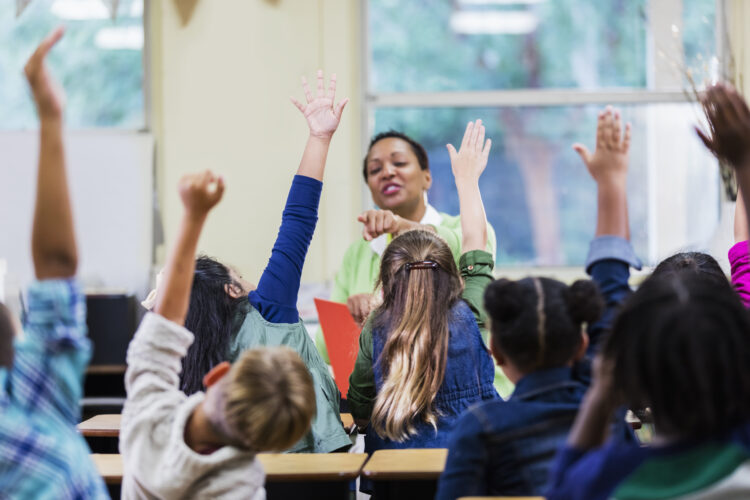
Classroom Observations: Examples of Best Practices in Structure, Type, & Method
Classroom observations are meant to help teachers improve their instructional practice and improve learning outcomes for students.
But for many educators, traditional, in-person classroom observations can not only be difficult to arrange but difficult to truly gain valuable feedback from when teachers can’t see what was happening in the moment.
Thankfully, as technology advances, so can classroom observation techniques.
Continue reading to learn more about classroom observation examples and best practices your district can utilize to improve educator performance and learning outcomes.
Table of Contents
What are the types of classroom observation, classroom observations: examples of what they have traditionally looked like, 6 pillars: the ideal example of classroom observation structure.
- Classroom Observations: Examples of What They Can Look Like Now With TORSH Talent
There are several different types of classroom observations that educators are familiar with:
- Formal evaluation
- Peer-to-peer observation
- Outside coaching
Formal Evaluation
Formal evaluations in the classroom are often used as part of job performance evaluations.
A formal classroom observation example might involve an administrator dropping in on a teacher’s classroom during a specific lesson. Normal evaluation observations are generally done once a year but may be done more often.
For some teachers, this type of evaluation is when they thrive. For others, this type of evaluation can be stressful and intimidating — especially when things don’t go as planned.
Peer-to-Peer Observation
Peer-to-peer observations are generally performed by other teachers. The goal of these observations is to provide the teacher with feedback on …
- Teaching methods
- Student interactions
- Instructional technique
- Classroom management
Peer-to-peer observations can be an excellent tool for teachers to learn from and support each other.
Collaborative Coaching
Classroom observations may also be done by instructional experts with the intent of supporting teachers in improving their practice and growing in their career. These observations are lower stakes than a formal observation by a school administrator.
Today, these observations may occur asynchronously rather than a coach sitting in a classroom watching a teacher deliver a lesson. Instead, using a professional learning management system like TORSH Talent, a teacher can record a lesson or part of a lesson using their phone and share it with their coach. The coach can then, at their convenience, watch the video and provide specific, time-stamped feedback. observation.
Together, the coach and teacher can discuss the teacher’s strengths, challenges, and effective (and ineffective) behaviors in the classroom. From there, teachers can work with their coaches to refine their practice, try new instructional approaches, and see their impact and growth through another recorded lesson.
Traditionally, classroom observations looked something like this:
A coach, peer, or administrator sits in the classroom during a lesson. Sometimes this observation is set ahead of time, with the teacher aware of what’s to come.
Other times, administrators set a window of time that they will be in the classroom to observe. These observations are typically done to evaluate teachers’ performance for a grade or formal job evaluation.
Traditional classroom observations often leave teachers feeling nervous, which is why the word “observation” often comes with a lot of emotional baggage for educators.
These reasons alone are enough for any district to want to make a switch on how classroom observations are done — especially when the end goal is always the same: improving learning outcomes for students.
So, if a traditional observation isn’t ideal for every teacher? What other options do districts have?
TORSH Talent allows districts to utilize technology and the power of video for observations. How do recorded classroom observations work?
In the sections below, we provide an ideal classroom observation example utilizing video and TORSH Talent.
#1: Pre-Observation
A pre-observation conference is a critical component of any classroom observation when the observation is for the purpose of professional learning. During this conference, coaches get a clear picture of what the teacher’s goals are, the areas in which they want support, and what type of feedback and guidance they’re seeking. A coach may also meet with district or school administrators to align with them on standards and organizational goals.
Essentially, a pre-observation conference builds trust between coaches and teachers and sets the foundation for a productive relationship.
An example of an ideal classroom pre-observation may look something like this:
Ms. Grey is a third-grade teacher. She has only been teaching for a few years and is struggling to keep her students engaged during math lessons using the district’s curriculum.
Ms. Grey has her first coaching session coming up and her pre-observation is scheduled. During Ms. Grey’s pre-observation meeting, the conversation goes something like this:
Coach : “Ms. Grey, I know you said you’re still fairly new to teaching. What are some of your goals for your third grade class?”
Ms. Grey: “ I’d love to help my students understand that math isn’t just about math on paper in the classroom, but that we use math every day in the world around us. Some of my students grasp the idea, while others struggle to move past things like dividing numbers on paper.”
Coach : “Can you give me an idea of what the outcome would look like in your upcoming lesson? What expectations do you have”
Ms. Grey: “My next math lesson is going to be set up in a ‘real life scenario’ at a grocery store in my classroom. I’m going to set up a “percentage off” sale for the students to do mental math to figure out what they will be paying for each item. Some of my students excel at this level of mental math, while others are struggling. I would really like this to be a fun learning experience for all my students. ”
Now, Ms. Grey’s coach has a very clear idea of what Ms. Grey needs coaching on, what to look for with her students, and how her metric of success.
Ms. Grey can choose the lesson she’s going to record and which clips to send her coach — feeling confident and comfortable that her coach is on her team, looking for ways to help her improve her students’ experience with this lesson.
#2: Observation and Evidence Collection
TORSH Talent provides administrators and coaches with a simple way to observe lessons and collect the evidence and data they need to help teachers meet their goals.
This observation and collection can be done in two ways:
- Observing the class in person while taking notes on the observations made in real-time, or
- Using a video recording to observe asynchronously
Using a tool like TORSH Talent to upload a recorded lesson and securely share it with a coach, gives the teacher, and the coach, the ability to watch, listen, and re-watch the lesson as needed to pinpoint moments where the teacher needs guidance.
Let’s look at Ms. Grey’s classroom again as an example.
Ms. Grey knows that she loses her students’ interest in math when she tries to apply it to a real-life situation — even when she decorates the classroom as a grocery store for roleplay learning. She’s chosen to record the activity for her coach.
The video inarguably captures evidence that her students aren’t uninterested but confused.
The coach now can dive into the recording without worrying about missing a key moment where the teacher excelled or where the students lost interest.
Not having to rely on memory in an active classroom situation enables coaches and teachers to see exactly what happened at each stage of the lesson. Now, the coaching conversation is based on a shared understanding and can focus on providing productive feedback for the teacher .
Video also allows teachers to see themselves in action and reflect on their practice.
#3: Observer Analysis
Once the data collection is complete, observers can begin addressing, analyzing, and sharing feedback about the lesson.
Once a teacher is aware of the need for change, it can make all the difference in giving them the motivation to make those changes. A coach performing an analysis of video recordings can provide feedback on specific moments.
With TORSH Talent, coaches can watch videos and provide meaningful feedback using built-in rubrics and frameworks that the district or school has uploaded to the platform. This ensures all observations occur through the same lens and recommendations align with agreed upon standards and evidence-based practices.
Video allows coaches to pinpoint specific moments in the lesson and prompt teachers to reflect on what occurred and offer their own suggestions for improvement. The best way to do this is to provide the teacher with the opportunity to answer questions about the recording.
Here are a few examples:
- “ I see from minute five to minute seven you realized your students weren’t as engaged as you were wanting. Next time, how could you help keep them engaged?”
- “In the clips that you sent, you did a wonderful job of connecting with your students, where do you feel you need to make improvements?”
- “You seem to have felt frustrated in minutes eight through ten when you couldn’t get your students back on track as quickly as you were hoping, what steps can you take in the future to help get them back on task?”
#4: Teacher Self-Analysis
Feedback is the catalyst to awareness, so, while an observer’s analysis of a lesson is important, more growth is typically accomplished through a teacher’s self-reflection .
The role videos play in classroom observations is incredible. Teachers analyzing videos of themselves during the moments they feel they need the most improvement can harness a lot of power.
One example of a successful teacher analysis is to have the teacher “self-evaluate” during classroom observations.
Have the teacher ask themselves the following questions:
- Did everything go according to plan during the lesson? If so, why do you think the lesson went so smoothly? If not, did you adapt your lesson to conquer any unexpected moments?
- Were the learning outcomes you expected met during the lesson?
- If you feel like you could have done things differently, what would you have done?
- Could you have boosted student engagement? Explain.
- What opportunities did you give students to expand their learning outside of the classroom?
#5: Discussion of Observation Outcomes
When done correctly, data collected and discussed during a teacher evaluation can help educators implement new strategies in the classroom.
In an ideal classroom observation, an example might look something like this:
After spending some time helping Ms. Grey reflect on her recorded lesson, her coach asks how Ms. Grey thinks she can get the outcomes she’s looking for in the future.
Several things are mentioned during this discussion:
Ms. Grey decides she is going to talk with her students to learn if they find the “real life” classroom scenarios fun and engaging. She tells her coach that she realizes that there may be better ways to approach teaching math in a way that makes sense to her third graders.
Ms. Grey also mentions she knows that one of the best ways for students to learn real-life examples is to have families help their students. She decides that every Friday she will send home a newsletter with a quick activity for families to do with their students that will enhance their math skills while they’re having fun.
#6: Goal Setting
At the end of their coaching session, Ms. Grey and her coach set achievable goals to ensure the recommendations from the observation happen.
Ms. Grey has made a weekly goal to make sure that newsletters go out every Friday.
She’s also started shifting how she teaches math to help her students stay engaged. Some weeks they’ll go outside to learn on the playground. Other weeks they’ll still have classroom “market days” to shop sales and practice real-life scenarios.
Classroom Observations: Examples of What They Can Look Like Using TORSH Talent
Video can take the pressure out of classroom observation for teachers and also enables more meaningful and specific feedback from coaches. Additionally, coaches can observe more lessons because they do not have to be sitting in a classroom for each one. Sustained, frequent coaching is a key factor in improving teacher practice and video makes that cost and time effective.
However, video can raise concerns about student privacy and security as well as add one more file and technology for coaches and teachers to deal with. The TORSH Talent Coaching and Professional Learning System consolidates and streamlines all coaching and professional learning activity into a single FERPA compliant platform.
- Teachers choose the lesson they want to record then upload the video to TORSH Talent using a secure app on their phone.
- Teachers can provide notes and questions to their coach about specific moments in the lesson or about what they thought went well or needed work.
- Coaches can view the video on their own time from home or school and provide time stamped feedback and recommendations based on a standard rubric.
- Coaches and teachers can communicate and share ideas asynchronously through TORSH Talent or schedule a one-on-one meeting using the platform’s video conferencing tool.
- Coaches can provide teachers with exemplars, readings, and even self-paced courses through the TORSH Talent resource library.
From utilizing video technology to recognizing “hinge-moments” in the classroom to providing teachers with the ability to look at their coaching sessions any time they need to, TORSH Talent provides schools with a “one-stop-shop” for all their professional learning needs.
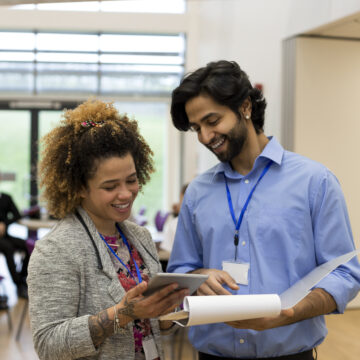
Exploring Various Coaching Models in Education

8 Resource Recommendations for Improving K-12 Teacher Retention
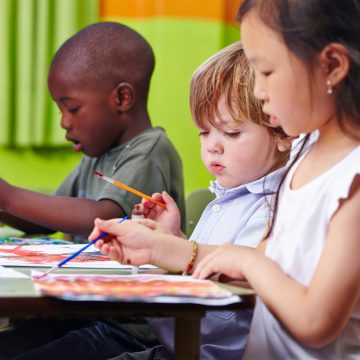
How Practice-Based Coaching Is Changing the Early Childhood Landscape in New Mexico
Thanks for subscribing to our blog! You should receive a confirmation e-mail soon.
Jump to navigation
- Inside Writing
- Teacher's Guides
- Student Models
- Writing Topics
- Minilessons
- Shopping Cart
- Inside Grammar
- Grammar Adventures
- CCSS Correlations
- Infographics
Get a free Grammar Adventure! Choose a single Adventure and add coupon code ADVENTURE during checkout. (All-Adventure licenses aren’t included.)
Sign up or login to use the bookmarking feature.
- 25 Writing Observation Reports
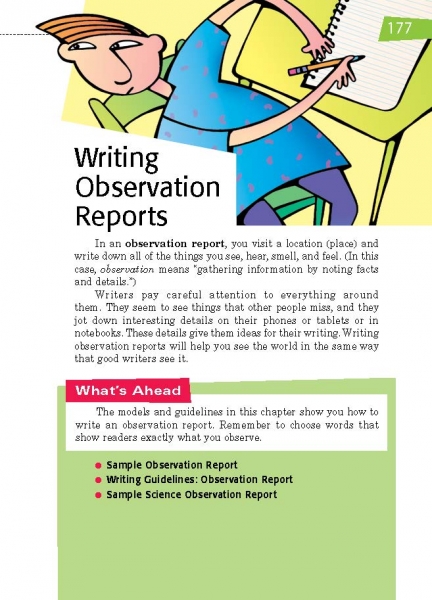
Start-Up Activity
Ask for a volunteer to read page 177 aloud. Then ask students to write a quick observation report based on the view from their desk. More specifically, for 5 minutes they should record what they see, hear, and feel around them without worrying about getting everything perfect in their sentences. Their goal is to record as many sensory details as they can. (Consider writing along with the students.) Afterward, ask for volunteers to share their reports for discussion. Note the different sensory details included.
Writing observation reports gives you an opportunity to teach the continuous form of the present tense ( is running, are sitting, etc.) English Language Learners often have difficulties with the continuous tense.
Think About It
“Writing is not apart from living. Writing is a kind of double living.”
—Catherine Drinker Bowen
State Standards Covered in This Chapter
- CCSS.ELA-LITERACY.W.6.2
- CCSS.ELA-LITERACY.W.7.2
- CCSS.ELA-LITERACY.W.8.2
LAFS Covered in This Chapter
Lafs.6.w.1.2, lafs.7.w.1.2, lafs.8.w.1.2, teks covered in this chapter, 110.22.b.10, 110.22.b.11.b, 110.23.b.10, 110.23.b.11.b, 110.24.b.10, 110.24.b.11.b, page 178 from all write, sample observation report.
Ask for a volunteer to read the sample aloud. Then discuss the text, using the side notes as a basic guide. During your discussion, have students identify any sensory details that the writer included.
Writing a "Showing" Paragraph
Help students show instead of tell.

Related Resource Tags
Click to view a list of tags that tie into other resources on our site
Page 179 from All Write
Writing guidelines: observation report.
Help students think of possible topics for their reports, or select a site for everyone to observe at the same time. Then model the use of a five senses organizer in case students want to use it. (Consider requiring students to address at least three different senses.)
When students are ready to write, point out that they can simply share details in the order they listed them or they can organize them with a beginning, middle, and ending. The model on page 178 features these three parts.
Writing Descriptions That "Show" Instead of "Tell"
Teach students to use sensory details.

Page 180 from All Write
Sample science observation report.
Be sure that science teachers know that All Write contains a sample science-related observation report. Consider teaming up with a science teacher to assign this type of report, with the details for the report being gathered in the science classroom and the writing carried out in your classroom.
- 01 A Basic Writing Guide
- 02 One Writer's Process
- 03 Traits of Effective Writing
- 04 Prewriting
- 05 Writing and Revising
- 06 Group Advising
- 08 Publishing
- 09 Writing Basic Sentences
- 10 Combining Sentences
- 11 Building Paragraphs
- 12 Writing with Style
- 13 Writing Terms and Techniques
- 14 Writing in Journals and Learning Logs
- 15 Writing Emails and Blog Posts
- 16 Writing Narratives
- 17 Writing Biographical Stories
- 18 Writing Informational Essays
- 19 Writing Explanations
- 20 Writing News Stories
- 21 Building Arguments
- 22 Writing Persuasive Essays
- 23 Writing Book Reviews
- 24 Other Responses to Literature
- 26 Writing Summaries
- 27 Writing Classroom Reports
- 28 Writing Poems
- 29 Writing Stories
- 30 Writing in Science
- 31 Writing in Social Studies
- 32 Writing in Math
- 33 Writing Business Letters
- 34 Understanding Media
- 35 Using Technology
- 36 Using the Library
- 37 Thinking and Writing
- 38 Thinking Clearly
- 39 Thinking Creatively
- 40 Reading Nonfiction
- 41 Reading Fiction
- 42 Reading Graphics
- 43 Improving Your Vocabulary
- 44 Viewing Skills
- 45 Note-Taking Skills
- 46 Planning Skills
- 47 Test Taking
- 48 Responding to a Prompt
- 49 Group Skills
- 50 Speaking Skills
- 51 Proofreader's Guide
- 52 Student Almanac
Delving into Human Behavior: the Art of Naturalistic Observation
This essay about the method of naturalistic observation in psychology, highlighting its unique ability to capture authentic human behavior in real-life settings. It discusses the importance of observing behavior in natural environments, where individuals interact spontaneously, offering insights into social dynamics and generating new research avenues. Despite challenges like observer bias and resource constraints, naturalistic observation remains a valuable tool for understanding the intricacies of human behavior and social interaction.
How it works
In the vast landscape of psychological research, one methodology stands out for its ability to capture the essence of human behavior in its most authentic form: naturalistic observation. Far from the sterile confines of a laboratory, naturalistic observation ventures into the heart of everyday life, unveiling the intricacies of human interaction and behavior within their natural habitat. It is a journey into the realm of genuine experience, where the complexities of social dynamics and individual quirks are laid bare for scrutiny and understanding.
At its core, naturalistic observation offers a unique perspective on human behavior by immersing researchers in the environments where it naturally unfolds. Whether it’s a bustling city street, a tranquil park, or a lively classroom, these natural settings serve as the stage for the drama of everyday life. Here, researchers become silent observers, blending into the background as they witness the ebb and flow of human interaction with an unobtrusive gaze. It is through this lens that the true essence of behavior is revealed, unencumbered by the constraints of artificial experimental setups.
One of the most compelling aspects of naturalistic observation is its ability to capture the nuances of social interaction in real-time. In these natural settings, individuals behave in ways that are spontaneous and unscripted, offering researchers a glimpse into the intricacies of human relationships and social dynamics. Whether it’s the subtle cues of nonverbal communication or the complex interplay of group dynamics, naturalistic observation allows researchers to peel back the layers of social behavior and uncover its underlying mechanisms.
Moreover, naturalistic observation holds immense potential for uncovering unexpected insights and generating new avenues of research. As researchers immerse themselves in the rich tapestry of everyday life, they may stumble upon intriguing patterns or phenomena that spark their curiosity. Perhaps it’s the way pedestrians navigate a crowded street or the dynamics of conversation in a bustling café. These seemingly mundane observations can serve as the seeds for further exploration, leading researchers down unexpected paths of inquiry and discovery.
However, naturalistic observation is not without its challenges and limitations. One of the most significant hurdles is the potential for observer bias, wherein the presence of the researcher may subtly influence the behavior of those being observed. To mitigate this risk, researchers employ a variety of strategies, such as blending into the environment or employing covert observation techniques. Additionally, naturalistic observation can be resource-intensive, requiring researchers to invest significant time and effort in data collection and analysis.
Despite these challenges, the benefits of naturalistic observation are undeniable. By providing a window into the complexities of human behavior in its natural habitat, this approach offers unparalleled insights into the intricacies of social interaction and individual behavior. It is a journey into the heart of what it means to be human, where the mundane becomes extraordinary and the ordinary becomes extraordinary. In the hands of skilled researchers, naturalistic observation is not just a tool for understanding behavior; it is a gateway to a deeper understanding of the human experience itself.
Cite this page
Delving into Human Behavior: The Art of Naturalistic Observation. (2024, May 12). Retrieved from https://papersowl.com/examples/delving-into-human-behavior-the-art-of-naturalistic-observation/
"Delving into Human Behavior: The Art of Naturalistic Observation." PapersOwl.com , 12 May 2024, https://papersowl.com/examples/delving-into-human-behavior-the-art-of-naturalistic-observation/
PapersOwl.com. (2024). Delving into Human Behavior: The Art of Naturalistic Observation . [Online]. Available at: https://papersowl.com/examples/delving-into-human-behavior-the-art-of-naturalistic-observation/ [Accessed: 14 May. 2024]
"Delving into Human Behavior: The Art of Naturalistic Observation." PapersOwl.com, May 12, 2024. Accessed May 14, 2024. https://papersowl.com/examples/delving-into-human-behavior-the-art-of-naturalistic-observation/
"Delving into Human Behavior: The Art of Naturalistic Observation," PapersOwl.com , 12-May-2024. [Online]. Available: https://papersowl.com/examples/delving-into-human-behavior-the-art-of-naturalistic-observation/. [Accessed: 14-May-2024]
PapersOwl.com. (2024). Delving into Human Behavior: The Art of Naturalistic Observation . [Online]. Available at: https://papersowl.com/examples/delving-into-human-behavior-the-art-of-naturalistic-observation/ [Accessed: 14-May-2024]
Don't let plagiarism ruin your grade
Hire a writer to get a unique paper crafted to your needs.

Our writers will help you fix any mistakes and get an A+!
Please check your inbox.
You can order an original essay written according to your instructions.
Trusted by over 1 million students worldwide
1. Tell Us Your Requirements
2. Pick your perfect writer
3. Get Your Paper and Pay
Hi! I'm Amy, your personal assistant!
Don't know where to start? Give me your paper requirements and I connect you to an academic expert.
short deadlines
100% Plagiarism-Free
Certified writers

IMAGES
VIDEO
COMMENTS
Key Takeaways: Write in the present tense to establish a sense of immediacy and connection to the event. Structure your essay with an introduction, body paragraphs, and a conclusion. Include a hook, background information, and a clear thesis statement in your introduction. Develop your thesis statement with arguments and facts in the body ...
The first step in taking field notes of your observation is, write down the necessary details of the subject. Also, you should include the time and place. In writing your findings, you should stay objective and factual. Also, don't forget to write a description of the setting and the materials involved. The readers of your observation essay ...
Classroom observation in this regard is a powerful tool to enable students and teachers to develop an analysis of feelings, evaluation of experiences and designing an action plan. For teachers to be effective, they need to recognize more than just their students' background and learning preferences. It is, therefore, not only desirable but ...
An observation is the act of seeing something that you have not seen before. The process of observing and watching. In addition to that, an observation is the act of seeing someone or something to gain information about it. An observation is the act of looking at something or someone in a curious or genuine manner.
My observation in the classroom was a window into this extraordinary world, a glimpse into the power of education to unlock the boundless potential within each student. Keep in mind: This is only a sample. Get a custom paper now from our expert writers. Get custom essay.
observations this semester in the classroom, I understand why you need to be flexible in the ~ teaching profession. Every class . T. observed this semester, was dissimilar from each other. Some classes harbored students who comprehended the material better, were ethnically di verse, special education, motivated and lazy students.
Writing a qualitative observation paper entails three processes. First, you record your observations of a particular setting or situation‐‐that is, take field notes. Next, you interpret those notes according to relevant criteria. Finally, you write a well organized paper that presents your observations and interpretations, usually with the ...
1. First-person narration. Surprisingly, this type of academic writing allows first-person narration. The main purpose is to give your readers a feeling that your memory is actually theirs. The words "I," "my," and "mine" become your best friends when you write an observation essay. 2.
3. Write the Body Paragraphs. The body of your observation essay is where you delve into the heart of your subject, exploring it in detail and sharing your insights with your reader. Each body paragraph should focus on a specific aspect of your observation, developing a clear point that supports your thesis statement.
Classroom observation is "the most direct method for the change facilitator to use in helping teachers to monitor and assess their own teaching practice" (Uys & Gwele, 2005, p.103). It allows monitoring teachers in action, to identify their strengths and weaknesses and develop and effective plan of action.
Classroom Management Observation and Assessment Essay (Critical Writing) Classroom management is an integral part of any institutionalized educational process. Its aim is not only to keep discipline in the classroom (which means not punishing students but rather developing desired behaviors (Khalsa, 2007, pp. 2, 6)) but also (and mainly) to ...
Chat with the writer 24/7. The key to an observation essay is precise sensory language . It may help to go through the senses one at a time, explaining exactly what the topic is like using the most descriptive language possible. You may also jump from impression to impression; just try to make sure that you write down every impression that you ...
A Comprehensive Guide to Effective Classroom Observation. 12/12/2019. By: Torsh. Classroom observation is critical in helping teachers get feedback on how to develop and mold their classroom management and instruction techniques. In this guide, we will break down the elements of classroom observation, methods, techniques, and more.
Traditionally, classroom observations looked something like this: A coach, peer, or administrator sits in the classroom during a lesson. Sometimes this observation is set ahead of time, with the teacher aware of what's to come. Other times, administrators set a window of time that they will be in the classroom to observe.
about my decision to become an educator. While observing students in the classroom setting, I was able to learn more about the teaching profession as a whole. I also learned more about myself as a developing teacher. I was able to use my experiences to form goals that will help me to become the best teacher that I can be.
Observation essay example #1: A Report on a Child Observation Project in a Preschool Class. A Report on Child Observation Project in a Preschool Class. Introduction. For this project, I observed my mother's preschool class for three hours, and three kids that she baby-sits on weekends for three hours.
independent writing. Whether it was writing stories, poems, or in journals, each lesson provided the students with an opportunity to get their thoughts down on paper. A 2 nd grade classroom that I was in even had a lesson on writing with partners. I have never even considered doing an activity around partner writing, so it was really neat to
The Classroom Observation. Classroom observation is a main approach of teaching research. Scholars or researchers use video to record the real whole class and observe the teachers and students' actions, words and the efficiency in the class. Though the observation, they analyze what approach is more suitable.
Writing Guidelines: Observation Report. Help students think of possible topics for their reports, or select a site for everyone to observe at the same time. Then model the use of a five senses organizer in case students want to use it. (Consider requiring students to address at least three different senses.) When students are ready to write ...
Classroom Observation Essay Examples. Improved Essays. 1218 Words. 5 Pages. Open Document. Essay Sample Check Writing Quality. Show More. I really enjoyed the time I spent in Mrs. Flinn's fourth grade classroom over Spring Break. I was able to observe for a total of four hours between Wednesday afternoon and Thursday morning.
This reflective report is based on the "The Sheltered Instruction Observation Protocol". (SIOP) (Echevarria, Vogt, & Short in Echevarria & Graves, 2015, pp. 52-53) which was used as. the ...
After my observations, I am self-assured and avid that I want to become a teacher and will be a good one at that. As a teacher, I believe you need to set the tone of the classroom and let them know that you are in control. The medium or atmosphere of the classroom needs to be accepting and eager to learn.
This essay about the method of naturalistic observation in psychology, highlighting its unique ability to capture authentic human behavior in real-life settings. It discusses the importance of observing behavior in natural environments, where individuals interact spontaneously, offering insights into social dynamics and generating new research ...